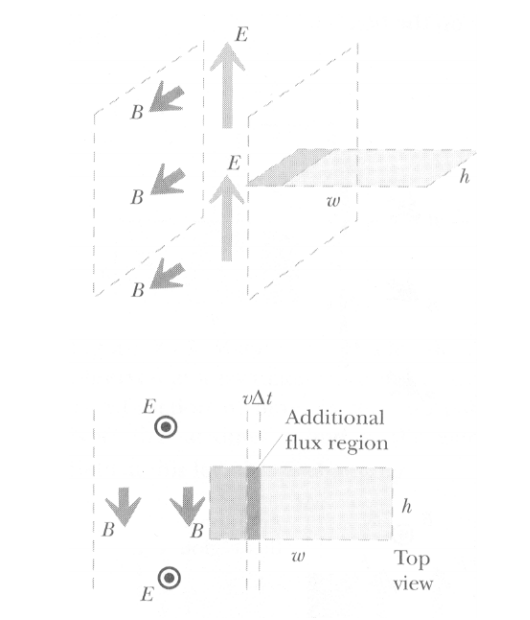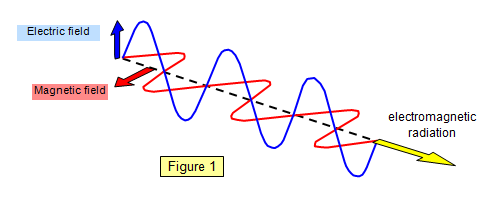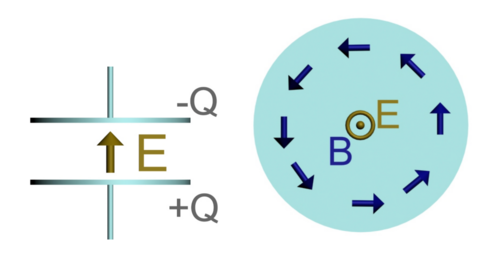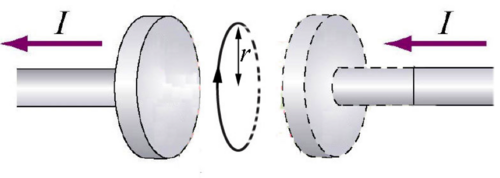Ampere-Maxwell Law: Difference between revisions
No edit summary |
No edit summary |
||
| Line 113: | Line 113: | ||
== See also == | == See also == | ||
The Ampere-Maxwell Law relates to the other Maxwell equations: | |||
*[[Gauss's Law]] | |||
*[[Magnetic Flux ]] | |||
*[[Faraday's Law ]] | |||
It might also help to read up on [[Maxwell's Electromagnetic Theory ]] | |||
Also for continuity purposes, it can be helpful to look at the incomplete Ampere's Law: | |||
*[[Ampere's Law]] | |||
===Further Reading=== | |||
Matter and Interactions: Volume 2 by Ruth Chabay and Bruce Sherwood (4th Edition) | |||
===External Links=== | |||
Maxwell's Equations: | Maxwell's Equations: | ||
Revision as of 21:13, 29 November 2017
Claimed by Maria Rivero Claimed by Yeon Jae Cho (FALL 2016)
Claimed by Stella Chen (Fall 2017)
Ampere-Maxwell Law
Ampere-Maxwell Law was discovered in the 1800's by James Clerk Maxwell. Maxwell proved in his paper that a time-varying electric field could be accompanied by a magnetic field. He thought of this after Faraday discovered that a time-varying magnetic field was accompanied by an electric field.
The time rate that is used for this equation is given by the derivative of the electric flux with respect to time. Because The derivative of the flux gives current over epsilon nod, the derivative of the electric flux times epsilon nod will also have units of amperes.
Ampere-Maxwell Law is also known as the Ampere's Circuital Law, and it shall not be confused with Ampere's Force Law.
Mathematical Model
Where
- B is the magnetic field,
- dl is the change in path,
- and the sum of I is the sum of the charges inside the path.
Example
Pick a closed, rectangular path in the xz plane with a height h and a width w. Calculate the speed v of the slab.
At a time change in t, we can calculate the area as the height (h) times the speed over the change in time. ⩟ A = v (⩟ t) h Because the electric field is constant in this region we can also calculate the change in electric flux over time as Evh(⩟ t) /(⩟ t) which is the same as Evh Calculating the path integral for the magnetic field we get that ∮B . dl = Bh cos 0 = Bh An important thing to notice is that there is no current I, so, using the Ampere-Maxwell Law we can see that
Bh = μ. [I+ ε. (vEh)]
but since there is no current,
B = μ. ε. (vE)
From Faraday's law we get that the emf equals the rate of change of the magnetic flux: Eh = Bvh
Substituting E = Bv into our previous equation we get that
B = μ. ε. (v(vB))
Solving for v we get that:
From the picture we see that the speed of light relates the a time varying electric and magnetic field.
What this implies
In the example above we saw that the speed of light relates the a time varying electric and magnetic field. This translates to the fact that an electromagnetic wave propagates at the speed of light.
Conceptual Question
The plot above shows a side and a top view of a capacitor with charge Q with electric and magnetic fields E and B at time t. The charge Q is:
1) Increasing in time
2) Decreasing in time
3) Constant in time
4) I don't know
Answer:
The unit vector N points out of the plane. Given that the magnetic field curls clockwise, the electric flux would be positive and decreasing. Hence E is decreasing. Thus Q must be decreasing, since E is proportional to Q.
Consider a circular capacitor, with an Amperian circular loop (radius r) in the plane midway between the plates. When the capacitor is charging, the line integral of the magnetic field around the circle (in direction shown) is
1) Zero
2) Positive
3) Negative
4) Can’t tell
Answer:
One thing to notice is that there is no enclosed current through the disk. When integrating in the direction shown, the electric flux is positive. Because the plates are charging, the electric flux is increasing. Therefore the line integral is positive.
Connectedness
How is this topic connected to something that you are interested in?
I am particularly interested in understanding medicine and how using all these waves we can help doctors understand and see different aspects of the human body.
How is it connected to your major?
I do not know how this would be connected to Industrial Engineering, however it is very useful for Electrical Engineering and Mechanical Engineering.
Is there an interesting industrial application?
As I mentioned before, this is very useful in medicine when creating the images for the MRI scanners in hospitals. But it is also important to generate electricity, to build computers and phones, etc. More generally, Maxwell's equations work for all devices that use electricity and magnets.
History
See also
The Ampere-Maxwell Law relates to the other Maxwell equations:
It might also help to read up on Maxwell's Electromagnetic Theory
Also for continuity purposes, it can be helpful to look at the incomplete Ampere's Law:
Further Reading
Matter and Interactions: Volume 2 by Ruth Chabay and Bruce Sherwood (4th Edition)
External Links
Maxwell's Equations: http://study.com/academy/lesson/maxwells-equations-definition-application.html
James Maxwell Biography: http://www.biography.com/people/james-c-maxwell-9403463
References
http://bulldog2.redlands.edu/fac/eric_hill/Phys232/Lectures/Ch%2023%20lect%201.pdf http://ocw.mit.edu/high-school/physics/exam-prep/electromagnetism/maxwells-equations/ http://ocw.mit.edu/courses/physics/8-02-physics-ii-electricity-and-magnetism-spring-2007/readings/summary_w13d1.pdf http://www.schoolphysics.co.uk/age16-19/Wave%20properties/Wave%20properties/text/Electromagnetic_radiation/index.html





